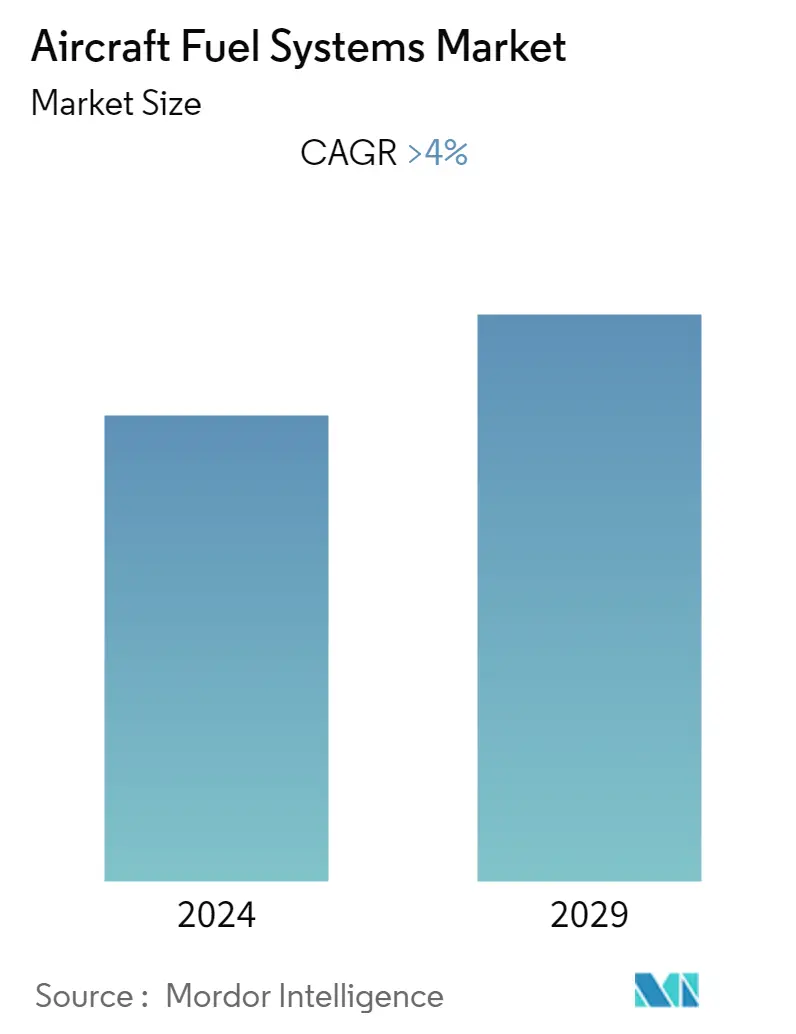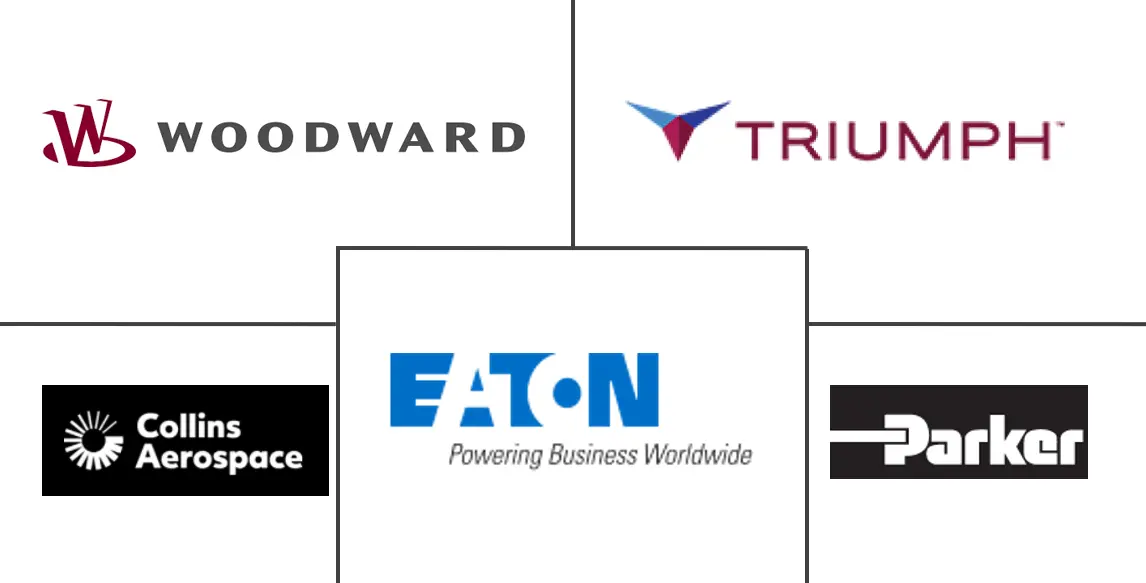Market Size of Aircraft Fuel Systems Industry

| Study Period | 2019 - 2029 |
| Base Year For Estimation | 2023 |
| Forecast Data Period | 2024 - 2029 |
| CAGR | 4.00 % |
| Fastest Growing Market | Asia Pacific |
| Largest Market | North America |
Major Players
*Disclaimer: Major Players sorted in no particular order |
Aircraft Fuel Systems Market Analysis
The aircraft fuel systems market is poised to register a CAGR of more than 4% during the forecast period (2022-2027)
The COVID-19 pandemic affected the aviation market in many ways, and the effect of the pandemic is expected to continue even during the forecast period. In the commercial sector, passenger traffic plummeted drastically in 2020 and 2021. With the advent of multiple pandemic waves in many countries, it is expected to take 2-3 years to recover completely. However, the return of the Boeing 737MAX into service and the recovery in domestic demand helped the OEMs in obtaining more orders and increasing aircraft deliveries in 2021, which in turn has helped the market for the related fuel systems.
The development of lightweight fuel system components is expected to propel market growth in the years to come. On the other hand, the advent of more electric architecture in aircraft subsystems is expected to bring structural changes to the fuel systems aboard the aircraft.
Aircraft Fuel Systems Industry Segmentation
The aircraft fuel system enables fuel to be loaded, stored, and delivered to the propulsion engines of the aircraft. The market is segmented by Type into Gravity Feed, Pump Feed, and Fuel Injection Systems. The market is also segmented by Application into Commercial Aircraft, Military Aircraft, General Aviation Aircraft, and UAVs. The UAV segment covers both commercial and military UAVs that are engine powered. The report also provides a detailed analysis of the market in major countries across different regions. The market sizing and forecasts have been provided in value (USD billion).
| Type | |
| Gravity Feed | |
| Pump Feed | |
| Fuel Injection Systems |
| Application | |
| Commercial Aircraft | |
| Military Aircraft | |
| General Aviation Aircraft | |
| UAV |
| Geography | |||||||
| |||||||
| |||||||
| |||||||
| |||||||
|
Aircraft Fuel Systems Market Size Summary
The aircraft fuel systems market is experiencing a period of growth, driven by the recovery of the aviation sector post-COVID-19 and advancements in technology. The market is expected to expand steadily, with significant contributions from the commercial aircraft segment. The resurgence in aircraft deliveries, particularly with the return of models like the Boeing 737MAX, has bolstered the demand for fuel systems. This growth is further supported by the development of lightweight components and the integration of more electric architectures in aircraft subsystems, which are anticipated to bring structural changes to fuel systems. The increasing preference for ultra-long-range aircraft is also prompting OEMs to enhance fuel carrying capacities, thereby driving market expansion.
The Asia-Pacific region is projected to witness the highest growth rate in the aircraft fuel systems market, fueled by the region's emergence as a prominent aviation hub. Countries like China, India, and Japan are investing heavily in both commercial and military aircraft, leading to a surge in demand for advanced fuel systems. The development of indigenous aircraft, such as India's Advanced Medium Combat Aircraft and Japan's F-X fighter jet, is expected to further boost market revenues. Major industry players, including Eaton Corporation, Parker Hannifin Corp., and Collins Aerospace, are actively expanding their market presence through acquisitions and joint ventures, focusing on innovative fuel system solutions. These developments, alongside the exploration of alternative fuel technologies like liquid hydrogen, are set to shape the future of the aircraft fuel systems market.
Aircraft Fuel Systems Market Size - Table of Contents
-
1. MARKET DYNAMICS
-
1.1 Market Overview
-
1.2 Market Drivers
-
1.3 Market Restraints
-
1.4 Industry Attractiveness - Porter's Five Forces Analysis
-
1.4.1 Threat of New Entrants
-
1.4.2 Bargaining Power of Buyers/Consumers
-
1.4.3 Bargaining Power of Suppliers
-
1.4.4 Threat of Substitute Products
-
1.4.5 Intensity of Competitive Rivalry
-
-
-
2. MARKET SEGMENTATION (Market Size and Forecast by Value - USD billion, 2018 - 2027)
-
2.1 Type
-
2.1.1 Gravity Feed
-
2.1.2 Pump Feed
-
2.1.3 Fuel Injection Systems
-
-
2.2 Application
-
2.2.1 Commercial Aircraft
-
2.2.2 Military Aircraft
-
2.2.3 General Aviation Aircraft
-
2.2.4 UAV
-
-
2.3 Geography
-
2.3.1 North America
-
2.3.1.1 United States
-
2.3.1.2 Canada
-
-
2.3.2 Europe
-
2.3.2.1 Germany
-
2.3.2.2 United Kingdom
-
2.3.2.3 France
-
2.3.2.4 Rest of Europe
-
-
2.3.3 Asia-Pacific
-
2.3.3.1 China
-
2.3.3.2 Japan
-
2.3.3.3 India
-
2.3.3.4 South Korea
-
2.3.3.5 Rest of Asia-Pacific
-
-
2.3.4 Latin America
-
2.3.4.1 Brazil
-
2.3.4.2 Mexico
-
2.3.4.3 Rest of Latin America
-
-
2.3.5 Middle-East and Africa
-
2.3.5.1 United Arab Emirates
-
2.3.5.2 Saudi Arabia
-
2.3.5.3 Egypt
-
2.3.5.4 Rest of Middle-East and Africa
-
-
-
Aircraft Fuel Systems Market Size FAQs
What is the current Aircraft Fuel Systems Market size?
The Aircraft Fuel Systems Market is projected to register a CAGR of greater than 4% during the forecast period (2024-2029)
Who are the key players in Aircraft Fuel Systems Market?
Parker Hannifin Corp., Woodward Inc., Triumph Group, Collins Aerospace (Raytheon Technologies Corporation) and Eaton Corporation plc are the major companies operating in the Aircraft Fuel Systems Market.

